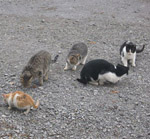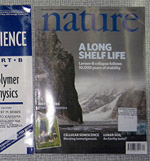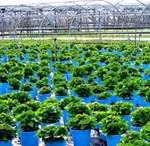Powerline corridors as breeding habitat for birds...
 Birds,
Birds,  Restoration
Restoration  Scrub-shrub habitat in Prince Edward County, Ontario.A new study finds that powerline corridors can provide important breeding habitat for shrubland birds, including several species of conservation concern. However the quality of the habitat depends largely on the width of the corridor.
Scrub-shrub habitat in Prince Edward County, Ontario.A new study finds that powerline corridors can provide important breeding habitat for shrubland birds, including several species of conservation concern. However the quality of the habitat depends largely on the width of the corridor.
Shrub-scrub habitat in eastern North America relies on natural disturbances such as fire and forest blowdown. Since these disturbances have diminished due to changes in land use and management, scrubland has decreased along with the birds that utilize these areas.
Today human disturbance of forest has become important for maintaining scrub-shrub. Powerlines can contribute to this effort. Along powerline corridors, the companies control excessive vegetation growth to prevent contact with the wires, and this can create and maintain shrubland. Common yellowthroat found in scrubland habitat. Image credit, Wolfgang Wadner.
Common yellowthroat found in scrubland habitat. Image credit, Wolfgang Wadner.
The study published in the journal Biological Conservation wanted to quantify how much scrubland birds use powerline corridors. The researchers also wanted to figure out whether avian abundance and nesting success is related to corridor width and the proximity to the habitat edge.
Lead author David King and his team surveyed bird abundance and species composition in a ~4,000 km2 (86% forested) area in western Massachusetts. Powerline corridors varied in widths ranging from 14.8 to 78.4 meters. Managers continued their routine practices of tree removal and herbicide sprays to maintain a “stable shrubland.” The researchers estimated nest success by locating and monitoring the offspring’s presence. If the nest was empty, they considered the nest a failure given that the birds were too young to fly.
Research findings...
- The researchers detected 64 species (1,639 individuals) in the two-year study. Out of the total amount spotted, 95% of the birds were from 7 species: common yellowthroat (Geothylpis trichas), chestnut-sided warbler (Dendroica pensylvanica) eastern towhee (Piplio erythropthalmus), field sparrow (Spizella pusilla), gray catbird (Dumetella carolinensis), indigo bunting (Passerina cyanea), and prairie warbler (Dendroica discolor).
- The lowest avian abundance was in the narrowest corridors. Below certain corridor widths, species started dropping out. For example, field sparrows dropped out below 30 meters and indigo buntings dropped out below 25 meters.
- The highest abundance was in corridors of medium width (approximately 40-60 meters).
- Nest success (i.e. the percentage of nest fledgling at one year) was around 40% with the figures greater in wider corridors. Survival of the 332 nests monitored was greater farther from the habitat edge.
This research confirms that powerline corridors can provide viable avian scrub-shrub breeding habitat. This is especially important since each of the seven most common species has a higher than average conservation priority in the Partner’s of Flight Species Assessment Database. The researchers recommend,
“Power utilities or other entities engaged in vegetation control activities in powerline corridors [should] adopt habitat management protocols such as those practiced at our sites so the potential of these corridors to provide habitat for scrub-shrub birds will be best realized.”
-Reviewed by Evyan Borgnis
King, D., Chandler, R., Collins, J., Petersen, W., & Lautzenheiser, T. (2009). Effects of width, edge and habitat on the abundance and nesting success of scrub–shrub birds in powerline corridors Biological Conservation, 142 (11), 2672-2680 DOI: 10.1016/j.biocon.2009.06.016




Reader Comments